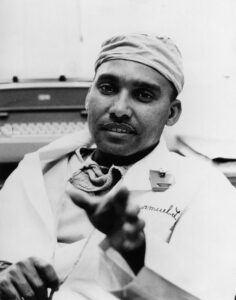 Before Samuel Kountz scrubbed in for a landmark surgical procedure in 1961, there was only one type of person who could possibly receive a transplanted kidney: a person with an identical twin.
Before Samuel Kountz scrubbed in for a landmark surgical procedure in 1961, there was only one type of person who could possibly receive a transplanted kidney: a person with an identical twin.
Kountz opened the door to wider transplant options by pioneering the use of the steroid methylprednisolone to prevent organ rejection. Over the years, this approach would become the standard not only for organ transplants but in many other medical procedures as well.
Born in 1930 in Lexa, Ark., as the grandson of a former slave, Kountz was led to pursue a medical career in part by his family. Because the deeply impoverished town had no doctor, Kountz’s Baptist minister father often served as the community’s nurse, and his mother as a midwife. But Kountz also said he was inspired by an experience he had when he was a young boy. Accompanying a young injured friend to the hospital, he was, as the New York Times put it in his obituary, “moved by the ability of doctors to ease his friend’s suffering.”
After earning a degree from Arkansas Agricultural, Mechanical and Normal College (now the University of Arkansas at Pine Bluff) and a master’s in biochemistry from the University of Arkansas, Kountz became the first Black person admitted into the medical school there. He did his residency at Stanford University School of Medicine, where he would later join the faculty. In 1967, he became the chief of kidney transplant service at the University of California at San Francisco, where he not only built what became recognized as one of the nation’s leading kidney transplant research centers, but also founded a center studying the ethical issues surrounding transplants.
In 1972, the State University of New York Downstate Medical Center in Brooklyn recruited Kountz to become a professor and chair of the department of surgery, a position he accepted in large part because of the opportunity to improve medical care for Black people living in urban areas. He would remain there until his death in 1981, after a long illness attributed to an unknown disease he contracted while traveling in South Africa.
At the time of his death, Kountz had performed some 500 kidney transplants, then believed to be the most in the world – and certain to be hundreds more than would have ever seemed possible before he blazed a new trail in transplant medicine.
